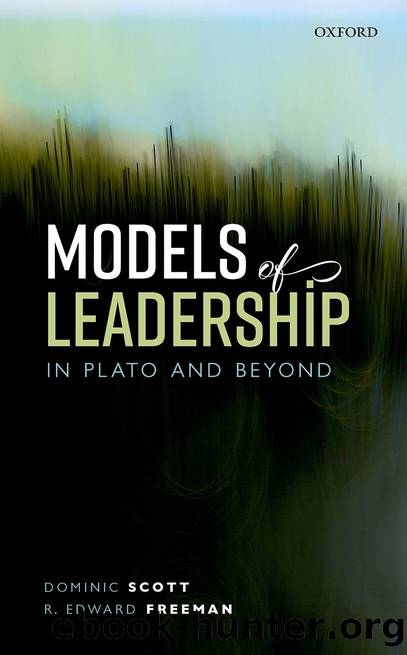Models of Leadership in Plato and Beyond by Dominic Scott & R. Edward Freeman

Author:Dominic Scott & R. Edward Freeman [Scott, Dominic & Freeman, R. Edward]
Language: eng
Format: epub
ISBN: 9780192574299
Publisher: OUP Oxford
Published: 2021-05-08T00:00:00+00:00
How does the weaver relate Platoâs to other models of leadership?
In the Introduction to this book, we discussed whether or not one should attempt to take a âone-size-fits-allâ approach to leadership: is the task to find a single all-encompassing definition? One advantage of studying Platoâs views on the subject is that he tends not to force a single definition on his readers. Instead, he offers us a variety of models, from which he can select the most appropriate according to the circumstances.
However, the Statesman seems different in this respect. Its purpose is to find the definition of the political leader. Plato does this by selecting the appropriate model (or âparadigmâ, as he calls it at 277d), but the status of this model, the weaver, seems rather different from what we have seen in some of the other cases. The navigator and the artist, as presented in the Republic, are used as pedagogical or rhetorical devicesâanalogies to help readers who may be struggling with Platoâs thought. As such, they are useful tools with which to think. But in the Statesman, he is much more self-conscious about the use of models or paradigms (277aâ279a), and is intent on finding exactly that model which captures the essence of statesmanship (305e). So here he does seem to follow the âone-size-fits-allâ approach.
What, then, would he have to say about his other models? Are they now to be discarded? We have already argued that he discards the shepherd in the Statesman 274eâ275c (see Chapter 7). But the other models can easily be kept in play. Indeed, two of them are implicit in the description of the weaverâs activity, as if deliberately incorporated: the teacher and the doctor. When talking of the way in which the weaver will bind everyone together with a common set of values, Plato stresses the need for education (308dâ310a): the weaver can only do his job if he supervises the education of the citizens. As for the doctor, it is easy to see how the model could be incorporated into the weaver: his task is to keep two different tendencies in balance, without letting either one become the defining characteristic of the state. This is the sort of balancing act we made central to the doctor in Chapter 2. If it is not achieved, the state or organization is beset with conflict and disunity (even war, as we saw in our Monnet case study). Interestingly enough, Plato refers to the conflict that the weaver tries to avoid as a âdiseaseââ the worst that could affect a state (307d).5
The model of the artist, though not mentioned in the Statesman, is nonetheless consistent with its requirement that the weaver unites all the citizens around a single vision of what is just and beneficial. The point of the shipâs captain is also relevant when you think of the way the captain needs to keep the crew united: Plato is now saying that the key point here is to ensure that their different temperaments can be woven together to preserve common purpose.
Download
This site does not store any files on its server. We only index and link to content provided by other sites. Please contact the content providers to delete copyright contents if any and email us, we'll remove relevant links or contents immediately.
Zero to IPO: Over $1 Trillion of Actionable Advice from the World's Most Successful Entrepreneurs by Frederic Kerrest(4223)
Machine Learning at Scale with H2O by Gregory Keys | David Whiting(4087)
Never by Ken Follett(3756)
Harry Potter and the Goblet Of Fire by J.K. Rowling(3756)
Ogilvy on Advertising by David Ogilvy(3481)
Shadow of Night by Deborah Harkness(3277)
The Man Who Died Twice by Richard Osman(2977)
Book of Life by Deborah Harkness(2850)
0041152001443424520 .pdf by Unknown(2766)
Will by Will Smith(2766)
My Brilliant Friend by Elena Ferrante(2758)
How Proust Can Change Your Life by Alain De Botton(2725)
The Tipping Point by Malcolm Gladwell(2688)
Purple Hibiscus by Chimamanda Ngozi Adichie(2618)
How to Pay Zero Taxes, 2018 by Jeff A. Schnepper(2577)
Hooked: A Dark, Contemporary Romance (Never After Series) by Emily McIntire(2480)
Rationality by Steven Pinker(2269)
Borders by unknow(2204)
Can't Hurt Me: Master Your Mind and Defy the Odds - Clean Edition by David Goggins(2136)
